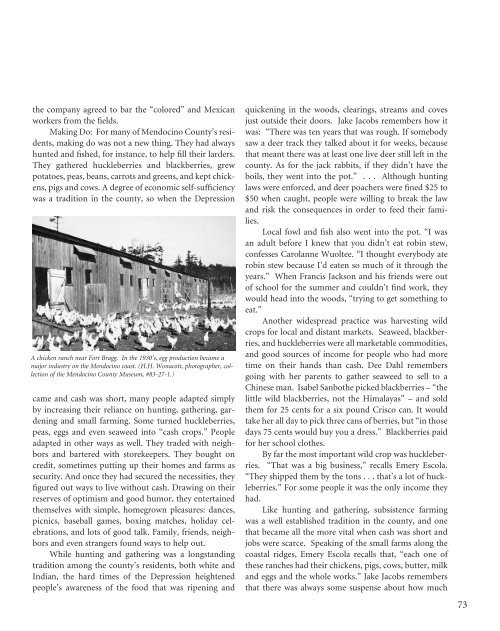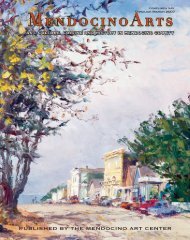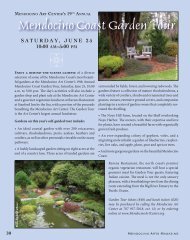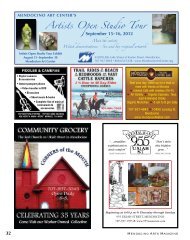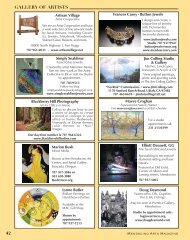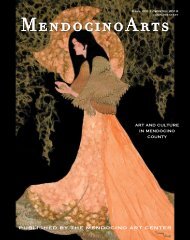bridges, huckleberries and robin stew - Mendocino Art Center
bridges, huckleberries and robin stew - Mendocino Art Center
bridges, huckleberries and robin stew - Mendocino Art Center
Create successful ePaper yourself
Turn your PDF publications into a flip-book with our unique Google optimized e-Paper software.
the company agreed to bar the “colored” <strong>and</strong> Mexican<br />
workers from the fields.<br />
Making Do: For many of <strong>Mendocino</strong> County’s residents,<br />
making do was not a new thing. They had always<br />
hunted <strong>and</strong> fished, for instance, to help fill their larders.<br />
They gathered <strong>huckleberries</strong> <strong>and</strong> blackberries, grew<br />
potatoes, peas, beans, carrots <strong>and</strong> greens, <strong>and</strong> kept chickens,<br />
pigs <strong>and</strong> cows. A degree of economic self-sufficiency<br />
was a tradition in the county, so when the Depression<br />
A chicken ranch near Fort Bragg. In the 1930’s, egg production became a<br />
major industry on the <strong>Mendocino</strong> coast. (H.H. Wonacott, photographer, collection<br />
of the <strong>Mendocino</strong> County Museum, #83-27-1.)<br />
came <strong>and</strong> cash was short, many people adapted simply<br />
by increasing their reliance on hunting, gathering, gardening<br />
<strong>and</strong> small farming. Some turned <strong>huckleberries</strong>,<br />
peas, eggs <strong>and</strong> even seaweed into “cash crops.” People<br />
adapted in other ways as well. They traded with neighbors<br />
<strong>and</strong> bartered with storekeepers. They bought on<br />
credit, sometimes putting up their homes <strong>and</strong> farms as<br />
security. And once they had secured the necessities, they<br />
figured out ways to live without cash. Drawing on their<br />
reserves of optimism <strong>and</strong> good humor, they entertained<br />
themselves with simple, homegrown pleasures: dances,<br />
picnics, baseball games, boxing matches, holiday celebrations,<br />
<strong>and</strong> lots of good talk. Family, friends, neighbors<br />
<strong>and</strong> even strangers found ways to help out.<br />
While hunting <strong>and</strong> gathering was a longst<strong>and</strong>ing<br />
tradition among the county’s residents, both white <strong>and</strong><br />
Indian, the hard times of the Depression heightened<br />
people’s awareness of the food that was ripening <strong>and</strong><br />
quickening in the woods, clearings, streams <strong>and</strong> coves<br />
just outside their doors. Jake Jacobs remembers how it<br />
was: “There was ten years that was rough. If somebody<br />
saw a deer track they talked about it for weeks, because<br />
that meant there was at least one live deer still left in the<br />
county. As for the jack rabbits, if they didn’t have the<br />
boils, they went into the pot.” . . . Although hunting<br />
laws were enforced, <strong>and</strong> deer poachers were fined $25 to<br />
$50 when caught, people were willing to break the law<br />
<strong>and</strong> risk the consequences in order to feed their families.<br />
Local fowl <strong>and</strong> fish also went into the pot. “I was<br />
an adult before I knew that you didn’t eat <strong>robin</strong> <strong>stew</strong>,<br />
confesses Carolanne Wuoltee. “I thought everybody ate<br />
<strong>robin</strong> <strong>stew</strong> because I’d eaten so much of it through the<br />
years.” When Francis Jackson <strong>and</strong> his friends were out<br />
of school for the summer <strong>and</strong> couldn’t find work, they<br />
would head into the woods, “trying to get something to<br />
eat.”<br />
Another widespread practice was harvesting wild<br />
crops for local <strong>and</strong> distant markets. Seaweed, blackberries,<br />
<strong>and</strong> <strong>huckleberries</strong> were all marketable commodities,<br />
<strong>and</strong> good sources of income for people who had more<br />
time on their h<strong>and</strong>s than cash. Dee Dahl remembers<br />
going with her parents to gather seaweed to sell to a<br />
Chinese man. Isabel Sanbothe picked blackberries – “the<br />
little wild blackberries, not the Himalayas” – <strong>and</strong> sold<br />
them for 25 cents for a six pound Crisco can. It would<br />
take her all day to pick three cans of berries, but “in those<br />
days 75 cents would buy you a dress.” Blackberries paid<br />
for her school clothes.<br />
By far the most important wild crop was <strong>huckleberries</strong>.<br />
“That was a big business,” recalls Emery Escola.<br />
“They shipped them by the tons . . . that’s a lot of <strong>huckleberries</strong>.”<br />
For some people it was the only income they<br />
had.<br />
Like hunting <strong>and</strong> gathering, subsistence farming<br />
was a well established tradition in the county, <strong>and</strong> one<br />
that became all the more vital when cash was short <strong>and</strong><br />
jobs were scarce. Speaking of the small farms along the<br />
coastal ridges, Emery Escola recalls that, “each one of<br />
these ranches had their chickens, pigs, cows, butter, milk<br />
<strong>and</strong> eggs <strong>and</strong> the whole works.” Jake Jacobs remembers<br />
that there was always some suspense about how much<br />
73


